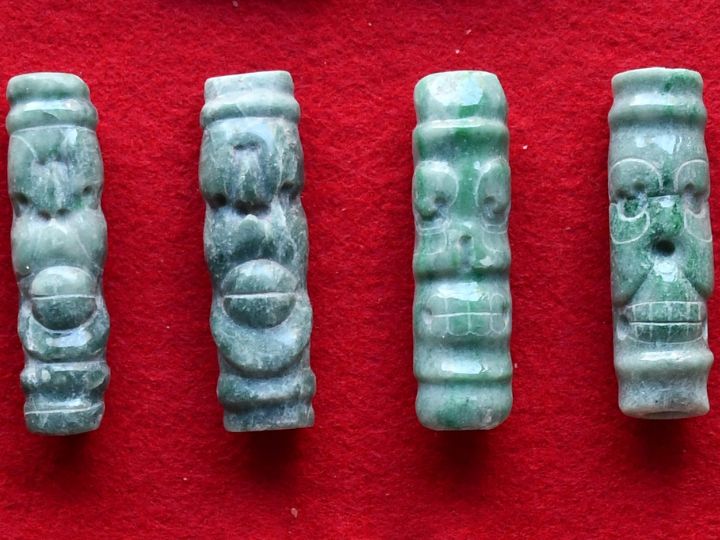Everything We Know About the Interstellar Object 3I/ATLAS



Committee directs Air Force to study heavy-lift launch capacity, LOX-methane safety protocols
The post Senate Armed Services’ defense bill includes mandates on space launch, missile defense, spectrum protection appeared first on SpaceNews.

Firefly Aerospace has filed paperwork to go public, seeking to raise an unspecified amount of money as part of a trend of space companies taking traditional approaches to public markets.
The post Firefly Aerospace files to go public appeared first on SpaceNews.




Varda Space Industries, a company developing spacecraft for microgravity life sciences and hypersonics research, has raised $187 million to expand the scope and cadence of its missions.
The post Varda Space Industries raises $187 million appeared first on SpaceNews.





Fashion designer Iris van Herpen has unveiled a bioluminescent dress that features 125 million living algae. The garment involved Herpen collaborating with designer Chris Bellamy as well as biophysicists Nico Schramma and Mazi Jalaal from the University of Amsterdam.

Bioluminescence is the production of light by a living organism, caused by a chemical reaction such as the molecule luciferin reacting with oxygen to release light.
The bioluminescent dress is composed of a gel material that incorporates millions of single celled bioluminescent algae of the species Pyrocystis lunula, named after their moon-like shape.
In the wild, the bioluminescent algae emit light as a defence mechanism. The flash serves as a warning signal that attracts secondary predators, which hunt the main predator of the cells.
In 2019, Jalaal, Schramma and colleagues began to study how the cells respond to mechanical stresses. By combining microscopy and mechanical tests, they were able to measure the light-emission of the cells and how it depended on deformation, which led to a mathematical model that described the light-production mechanism (Phys. Rev. Lett. 125 028102).
The researchers then worked with Chenghai Li and Shengqiang Cai at the University of California San Diego and bioluminescence researcher Michael Latz from the Scripps Institution of Oceanography in San Diego.
They incorporated the cells in a gel matrix to create a flexible yet resistant substance that emits light upon deformation and movement while at the same time keeping the cells alive.
Bellamy and van Herpen developed and refined the bioluminescent material and incorporated it into a spectacular “living” garment, which on Monday was part of van Herpen’s new fashion collection – Sympoiesis – that was unveiled at Paris Haute Couture Week.
The post Physics meets fashion as bioluminescent dress debuts at Paris Haute Couture Week appeared first on Physics World.

There was a time when looking up at the night sky stirred a visceral sense of wonder. The moon landing, the Shuttle launches, the Voyager missions — these were moments that gripped the public imagination and filled people with a sense of shared destiny beyond Earth. But somewhere along the way, something shifted. Despite unprecedented […]
The post We’ve lost our ability to be awed by space appeared first on SpaceNews.

A Chinese Shiyan satellite appears in a low-inclination orbit never before used by the country, after a week-long detection delay and uncertainty over its mission.
The post Experimental Chinese satellite turns up in unexpected orbit appeared first on SpaceNews.

NASA officials say there is a “strong chance” that the next test flight of Boeing’s CST-100 Starliner commercial crew vehicle will be uncrewed.
The post NASA considering flying only cargo on next Starliner mission appeared first on SpaceNews.

On May 28, China launched Tianwen-2, a robotic mission that aims to land on a tumbling near-Earth asteroid barely the size of a conference room, extract samples and send them back to Earth. Yet, the actual spacecraft remains publicly shrouded in mystery and international cooperation on the mission is limited. For most space agencies, this […]
The post China eyes the moon, Mars and space dominance appeared first on SpaceNews.
Astronomers at the University of Hawai’i’s Institute for Astronomy (IfA) in the US have detected what they say are the most energetic cosmic explosions known to have occurred since the the universe began. These colossal events, dubbed extreme nuclear transients (ENTs), emit at least 10 times as much energy as the previous record holders, and studying them could open a new window into physical processes that take place at very high energies.
ENTs occur when stars that are at least three times as massive as the Sun pass so close to a supermassive black hole that its colossal gravity shreds them to pieces. The resulting string of matter then spirals into the black hole in a phenomenon known as accretion.
Such events are extremely rare, occurring a few hundred times less frequently than supernovae. However, when they do happen, they release huge amounts of energy, producing long-lasting flares that can then be detected on Earth.
Optical transient surveys have spotted several classes of accretion-powered flares over the past decade or so, explains Jason Hinkle, who led the study as part of his PhD research at the IfA. Examples include tidal disruption events, rapid turn-on active galactic nuclei and ambiguous nuclear transients.
The new ENTs are a different kettle of fish, however. They release between 0.5 × 1053 and 2.5 × 1053 erg (0.5‒2.5 × 1046 J) making them at least twice as energetic as any other known transient. “They are also 10 times as bright (emitting 2 × 1045 to 7 × 1045 erg per second) and remain luminous for years, far surpassing the energy output of even the brightest known supernova explosions,” Hinkle says.
Hinkle began searching for ENTs at the beginning of his PhD studies by sifting through data from the European Space Agency’s Gaia mission. Gaia is ideal for such a search as it has been observing the full sky since late 2014. As a space-based mission, it also typically has shorter seasonal breaks than ground-based surveys.
Hinkle’s search for smooth, high-amplitude, long-lived signals revealed two possible sources. Designated Gaia16aaw (AT2016dbs) and Gaia18cdj (AT2018fbb), each comes from the centre of a distant galaxy. For Gaia16aaw, that galaxy bears the catchy name WISEA J041157.03-420530.8. Gaia18cdj, for its part, lies within the equally memorable WISEA J020948.15-420437.1
In 2020, astronomers began observing these sources with space-based UV/X-ray missions and ground-based facilities, including the University of Hawai’i’s Asteroid Terrestrial-impact Last Alert System and the W M Keck Observatory. “These gave us the first indication that we were seeing something special,” Hinkle says. “When the Zwicky Transient Facility [a wide-field optical survey] published data on a third similar event, ZTF20abrbeie, also sometimes called ‘Scary Barbie’ (AT2021lwx), in 2023, it gave us additional confidence that we had found a rare, new class of transient phenomena.”
These data show that the brightness of the light emitted from ENTs increases for more than 100 days, peaks, and then slowly declines over a period of more than 150 days. ENTs also produce infrared light, which suggests that circumnuclear dust is being heated up and reemitted at longer wavelengths, Hinkle says.
The fact that Gaia16aaw and Gaia18cdj are located relatively close to the centres of their host galaxies (within 0.68 and 0.25 kpc, respectively) confirms their status as nuclear transients, he adds. Their long timescales and high peak luminosities also suggest that they originate from accretion onto a supermassive black hole. “The way they accrete is very different from normal black hole accretion, however, which typically shows irregular and unpredictable changes in brightness,” Hinkle explains. “Instead, the smooth and long-lived flares of ENTs imply a distinct physical process – the gradual accretion of a tidally disrupted star by a supermassive black hole.”
According to IfA team member Benjamin Shappee, ENTs provide a valuable new tool for studying massive black holes in distant galaxies. Since they are so bright, they can be seen across vast cosmic distances, equivalent to redshifts between z = 4 and 6. This means they could give astronomers new information about black hole growth when the universe was less than half its present age, during a period when galaxies were forming stars and feeding their supermassive black holes up to 10 times more vigorously than they are today.
Now that astronomers know what to look for, Hinkle says that new survey instruments such as the Vera C Rubin Observatory and NASA’s Roman Space Telescope should turn up several ENTs per year. “From a physics perspective, building a sample of ENTs will give us the best look yet at massive black holes in the early universe, especially the large majority of those that are not otherwise accreting,” he says. “This will serve as an excellent complement to studies of accreting black holes in the early universe with the James Webb Space Telescope, for example.
“We have a great starting point, but as with many things in observational astronomy, we need larger samples to gain a fuller understanding of how these events work and how we can best use them to test fundamental physics.”
The present study is detailed in Science Advances.
The post Astronomers observe the biggest booms since the Big Bang appeared first on Physics World.